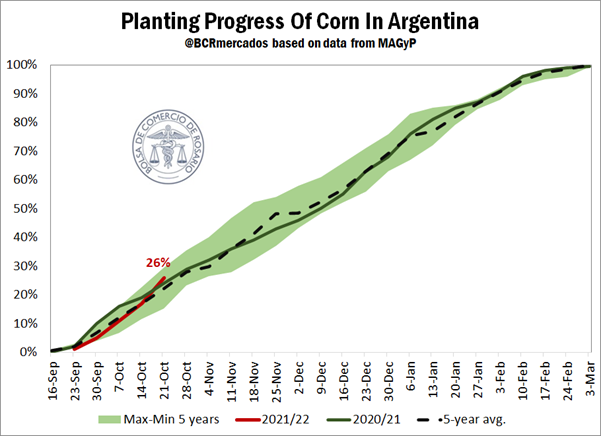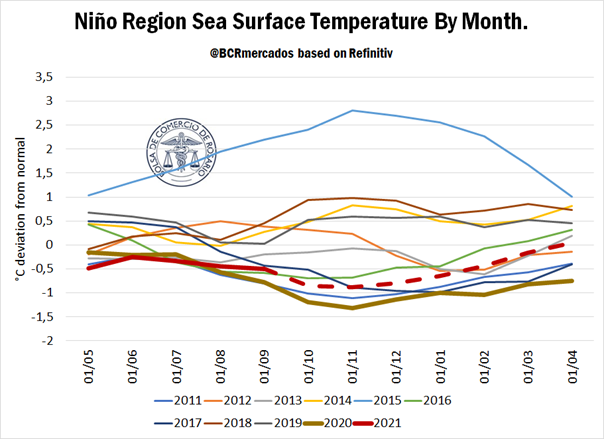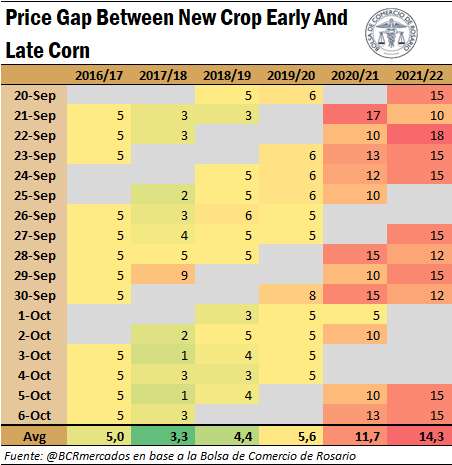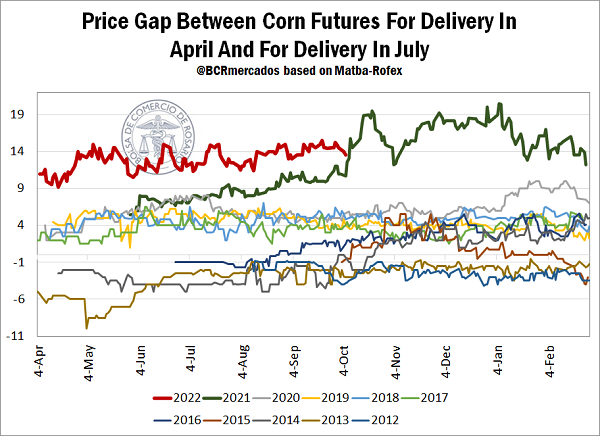Corn 2021/22: price gap between early and late crops soars to five-year high
Corn 2021/22 heads to becoming the big star of the new crop. With an area growth of over 7% regarding the current crop, the first forecasts give a glimpse of a record production of over 56 Mt. In the face of these forecasts, planting of early corn hast already started in a large part of the country, and 26% of the intended planting area has been covered. Also, during last week, planting efforts were intensified and the planting rate of the previous crop was exceeded, as well as the average of the last five years.
However, the new crop faces a threat in the climatic issue. The possibility of a new Niña year grew as months went by and, according to the last report by the International
Research Institute for Climate and Society (IRI), and the highest probability of a Niña event will occur during the trimester November-December-January.
Whether a year is Niño or Niña depends on the surface temperature of the water in the Pacific Ocean region near the Equator line. When the water temperature is higher than normal, we are in the presence of a Niño year, which is usually connected to higher precipitation and lower temperatures South of Brazil and on a large part of the productive region in the central-Northern area of Argentina. Conversely, when the water in that region of the ocean is colder than usual, we are in the presence of a Niña year, global phenomenon linked to precipitations below normal and higher temperatures in the case of our country.
Anyway, at least in principle, the intensity of the Niña phenomenon of the next few months will be moderate. In the next graphic we can observe the evolution of the surface temperature of the Pacific Ocean in the above mentioned region. As can be appreciated, in August and September, the temperature of the surface water in that region of the Pacific was above the records of year 2020. Also, the forecasts for the upcoming months indicate that the intensity of the phenomenon would not be so marked.
Additionally, it is necessary to highlight that what happens with the Pacific is a global climatic phenomenon, and therefore, it influences all regions of the planet, but it is not the only determining factor of the climate. There are also regional phenomena that can add humidity, regardless of the situation of the Pacific Ocean. For example, the Atlantic Ocean can bring its own contribution of humidity to the region. However, one of the main inconveniences is that the temperature of this ocean is more volatile, and therefore it is not possible to forecast in the medium term the contribution it will generate.
Even so, with the perspective of lower precipitation, it is forecast that a higher share of parcels will be planted with late varieties, whose harvest is carried out during July-August, to the detriment of early plantings, whose harvest is performed mainly during March-April. In the same manner as happened in 2020/21, this is based on the fact that a large number or growers would delay planting in order to prevent the crop to endure its critical period at the time a peak of this Niña event is expected. This strategy has been successful during the last crop: the yields of late corn and second crop corn were higher than expected, which pushed productivity on a national level 0.3 tons above the average of the last five years.
However, this affects the moment of the year when the highest volume of grains enters the market, so it has an impact on prices. This year, just as the previous one, the price gap between early and late corn has rocketed. Based on the prices offered in the Physical Grain Market of the Rosario Board of Trade, taking into account the prices offered for delivery on April as indicators of early corn, and the ones offered for delivery in July as indicators of late corn, it can be appreciated that the gap between both segments is, at least, on a five-year maximum, even above the gap registered by this time last year.
If we take the period between the end of September and beginnings of October of the last five crops, the average difference between the prices offered for the new crop season was of US$ 14.3 /t, exceeding the average gap of last year. Also, another remarkable aspect is that, in previous years, when the climatic situation was favourable at the time of planting and not many growers chose to plant late corn, the gap differential was considerably below current values.
If we try and extend the analysis through time to see how this gap has behaved in previous years, we can use the future contracts at Matba-Rofex. Taking into account the contract for corn with delivery in Rosario in April and July of each year as reference prices of early and late corn, respectively, we can see that the price gap in favour of early corn has been at maximum levels for the moment of the year in comparison with previous years.
However, even when it has been consistently high, the differential has not yet exceeded the peak corn registered in 2020/21 at the beginning of January this year, when the gap between the futures contracts reached US$ 20.5/t.



